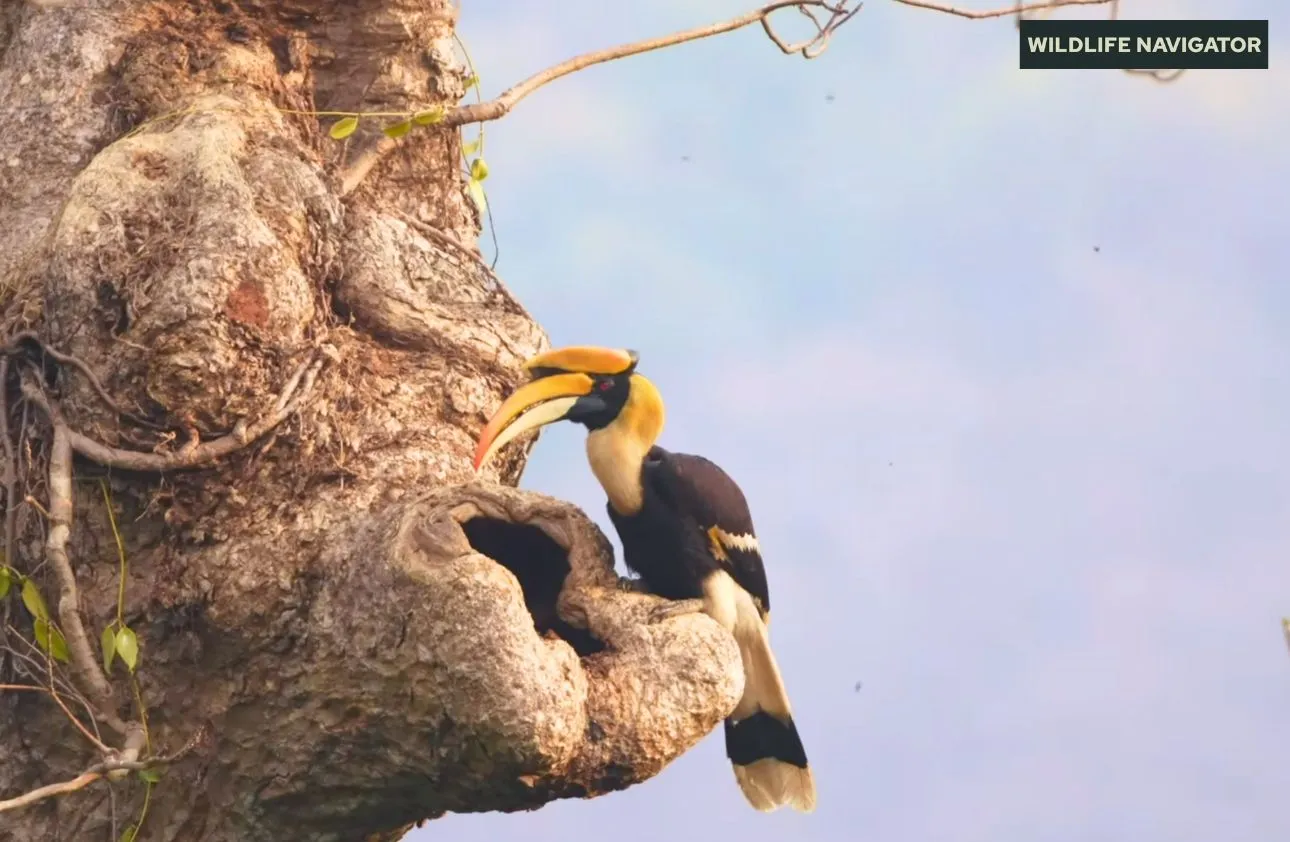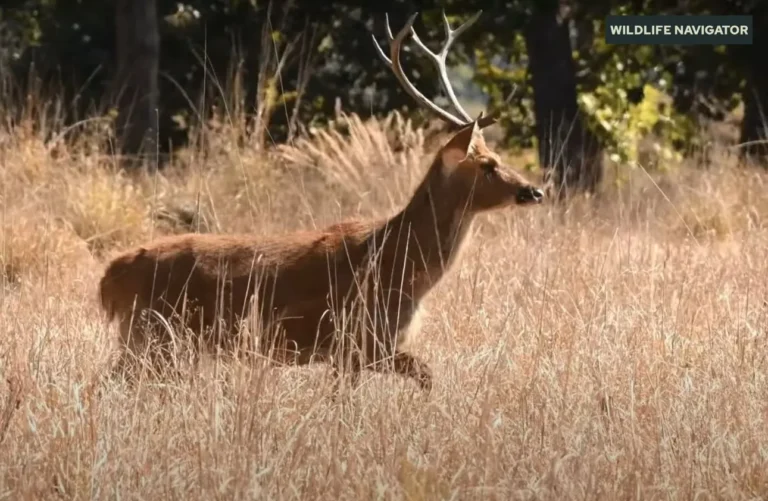Great Hornbill – Facts, Habitat, Behavior & More

The Great Hornbill (Buceros bicornis), also known as the Great Pied Hornbill or the Great Indian Hornbill, is often called the “Forest’s Crowned Giant.” It is one of the most striking and iconic birds of the Indian subcontinent and Southeast Asia. Known for its impressive size, bold casque (the prominent helmet-like structure on its bill), and vibrant colours, this bird captures the imagination of wildlife enthusiasts, photographers, and birdwatchers alike.
Found primarily in dense forests, the Great Hornbill plays a crucial role in maintaining ecological balance. As a frugivore, it disperses seeds of many large tropical trees, helping regenerate forest habitats. Its majestic flight, loud calls, and unique nesting behaviour have also made it a symbol of mystery and reverence in many tribal cultures across India and Southeast Asia.
The Great Hornbill is not just a bird but a living emblem of forest health and biodiversity. Spotting one in the wild is considered a special experience, often forming a highlight for nature lovers visiting national parks, wildlife sanctuaries, and bird reserves.
Physical Appearance and Identification
The Great Hornbill is one of the largest hornbill species, measuring about 95 to 130 cm in length with a wingspan of 1.2 to 1.5 meters, making it a truly imposing sight in the forest canopy. Adult males are particularly striking, with a bright yellow and black casque atop a large curved bill. Females, while similar in shape, usually have a smaller, paler casque and slightly duller plumage.
Its body is predominantly black, with a white neck, throat, and underparts. The tail feathers are long and mostly white with black tips, which become very noticeable during flight. The bird’s vivid yellow eyes, sometimes contrasted by a dark ring, and the casque, which is hollow and lightweight, give it a unique silhouette that is easily recognisable even from a distance.
Unique Features:
- The casque is used for amplifying calls and in combat during courtship.
- Large wings and strong flight muscles allow it to glide gracefully between forest trees.
- Males and females can be distinguished by size, casque shape, and eye colour.
Behavioural Identification:
- Great Hornbills are highly vocal; their loud, cackling calls often precede sightings.
- They often fly in pairs or small groups, sometimes soaring high above the canopy.
Great Hornbill Habitat and Distribution
The Great Hornbill thrives in dense, undisturbed forests, particularly in tropical and subtropical evergreen forests, moist deciduous forests, and occasionally in semi-evergreen habitats. These birds prefer areas with tall, mature trees that provide nesting cavities, fruiting trees, and cover from predators.
Geographic Range
- India: Western Ghats, Northeastern states (Arunachal Pradesh, Nagaland, Assam, Meghalaya), and central India (Kanha and Pench National Parks).
- Southeast Asia: Myanmar, Thailand, Bhutan, Malaysia, and parts of Indonesia.
Altitude Preferences
- Found at elevations ranging from 300 meters to 1500 meters, with some sightings above 1800 meters in the Eastern Himalayas.
Ecological Significance
- The Great Hornbill is considered an umbrella species, meaning its conservation helps protect a wide range of other forest species.
- Prefers fruiting trees such as fig trees, which also support other frugivores like pigeons, monkeys, and bats.
Visualizing Distribution
- Sightings are concentrated in protected areas and national parks due to habitat loss in non-protected regions.
- The best chances of spotting them are in large, contiguous forest patches rather than fragmented landscapes.
Behaviour and Ecology
The Great Hornbill is a fascinating species not just because of its size and appearance, but also due to its unique behavioural and ecological traits. Typically found in pairs or small family groups, these birds are highly social and form strong pair bonds that often last for life. They are diurnal, most active during the early morning and late afternoon, when they forage for fruits or travel between feeding trees.
Flight and Movement
Great Hornbills are powerful fliers, using slow, deliberate wingbeats interspersed with glides. Their long tail and broad wings allow them to maneuver through dense forest canopies with surprising agility. When flying in pairs, they often emit loud calls, which can carry over long distances, helping maintain group cohesion.
Breeding Behavior
One of the most remarkable aspects of Great Hornbill behaviour is their breeding strategy. During nesting, the female seals herself inside a tree cavity using mud, droppings, and fruit pulp, leaving only a small slit for the male to deliver food. This exclusive maternal care period, which can last several months, ensures the safety of eggs and chicks from predators.
Role in the Ecosystem
Ecologically, Great Hornbills are a keystone species. By feeding primarily on fruits, they disperse seeds of large forest trees, contributing to forest regeneration and biodiversity. Their presence is an indicator of healthy, undisturbed forests, and declines in hornbill populations often reflect broader environmental issues like habitat loss and deforestation.
Social and Vocal Behaviour
- Loud, cackling calls signal territory or mating readiness.
- Playful interactions between juveniles and adults reinforce social bonds.
- Occasionally, hornbills may interact with other frugivores like monkeys and pigeons around fruiting trees.
Diet and Foraging
The Great Hornbill is primarily frugivorous, meaning its diet mainly consists of fruits, although it occasionally consumes small animals such as insects, lizards, and birds. Its feeding habits make it an important seed disperser, crucial for maintaining the health and diversity of tropical forests.
Primary Diet
- Fruits: Figs are the favourite, but it also feeds on mangoes, guava, and other forest fruits.
- Occasional animal prey: Insects, small reptiles, and occasionally bird eggs supplement protein intake, especially for growing chicks.
Foraging Behavior
Great Hornbills are diurnal feeders, most active during early mornings and late afternoons. They often forage in the upper canopy, moving from one fruiting tree to another, and sometimes descending to lower branches or forest edges. Their large bills and strong neck muscles allow them to pluck fruits efficiently and even break branches to access hidden food.
Ecological Interactions
- By consuming fruits whole and dispersing seeds far from the parent tree, hornbills play a vital role in forest regeneration.
- They may feed alongside other frugivores like monkeys, pigeons, and other hornbill species, occasionally competing but mostly coexisting peacefully.
- Their presence signals a healthy ecosystem; areas devoid of hornbills often indicate habitat degradation.
Tips for Birdwatchers
- Look for hornbills in fruiting trees, especially figs, during the early morning or late afternoon.
- Loud calls often indicate feeding activity nearby.
- Observing their foraging behaviour provides insights into forest dynamics and seed dispersal patterns.
Breeding and Life Cycle
The Great Hornbill exhibits one of the most fascinating and unique breeding behaviours among birds. Its life cycle is closely tied to the dense forest habitats it inhabits, making nesting success highly dependent on mature, undisturbed trees.
Nesting Habits
During the breeding season, the female selects a large tree cavity to lay her eggs. She then seals herself inside the cavity using a mixture of mud, droppings, and fruit pulp, leaving only a narrow slit. This enclosure protects her and the eggs from predators such as snakes, monitor lizards, and small mammals. The male provides all food during this period, delivering fruits, insects, and small prey through the slit to sustain the female and, later, the chicks.
Eggs and Incubation
- Clutch size usually ranges from 1 to 4 eggs.
- Incubation lasts around 38–40 days, during which the female remains entirely enclosed.
- The male tirelessly forages and feeds the female, ensuring she and the eggs survive this vulnerable period.
Chick Rearing
Once the chicks hatch, the female may remain inside the cavity for several weeks, only emerging when the chicks are ready to fledge. Both parents continue to feed the chicks until they are capable of independent flight, usually after two to three months.
Challenges and Survival
- Habitat loss reduces available nesting cavities, affecting reproduction rates.
- Predation, hunting, and environmental disturbances also pose significant threats.
Interesting Facts
- The hornbill’s unique sealing behaviour is a rare adaptation among birds and highlights their specialised reproductive strategy.
- They often return to the same nesting sites year after year if conditions remain favourable.
Conservation Status and Threats
The Great Hornbill (Buceros bicornis) is currently classified as Vulnerable on the IUCN Red List, reflecting significant declines in population across its natural range. The species faces several threats, most of which are linked to habitat loss, hunting, and human interference.
Major Threats
- Deforestation and Habitat Fragmentation
- Large-scale logging, agricultural expansion, and urban development have reduced dense forest habitats essential for feeding and nesting.
- Loss of mature trees limits available nesting cavities, directly impacting breeding success.
- Hunting and Poaching
- In some regions, hornbills are hunted for their casques, feathers, and meat.
- Illegal trade in live birds, though less common, poses a significant threat to local populations.
- Environmental Disturbances
- Tourism, road construction, and forest fires disrupt nesting and foraging sites.
- Fragmented forests make hornbills more vulnerable to predators and reduce food availability.
Conservation Efforts
- Protected Areas: Many populations are safeguarded in national parks and wildlife sanctuaries such as Kanha, Periyar, and Namdapha.
- Community-Based Programs: Local communities are being involved in nest tree protection, awareness campaigns, and sustainable eco-tourism initiatives.
- Captive Breeding and Education: Zoos and conservation centres in India (like Arignar Anna Zoo and Mysore Zoo) support education and breeding programs to raise awareness about hornbill conservation.
Ecological Significance
- As keystone species, declining hornbill populations can have cascading effects on forest ecosystems, reducing seed dispersal and forest regeneration.
- Conserving Great Hornbills indirectly protects a wide range of other forest species.
Hornbills in Culture and Folklore
The Great Hornbill has fascinated humans for centuries, not only for its striking appearance but also for its symbolic and cultural significance in many regions of India and Southeast Asia. Tribes and local communities have long revered the hornbill, weaving it into their myths, rituals, and traditional art.
Cultural Significance
- In Northeast India, particularly among the Arunachal Pradesh and Nagaland tribes, hornbills are seen as symbols of strength, purity, and fidelity. Their presence in forests is often associated with spiritual protection.
- The hornbill is celebrated in the Hornbill Festival of Nagaland, an annual event that showcases local culture, music, dance, and crafts. The festival is named after the bird to highlight its cultural and ecological importance.
- Many tribes use hornbill feathers and beaks in ceremonial headgear and ornaments, although modern conservation efforts discourage hunting for these purposes.
Symbolism in Art and Literature
- Hornbills often appear in folk tales and carvings, symbolising vigilance, wisdom, and fertility.
- In some regions, seeing a Great Hornbill in the forest is considered an omen of good fortune or a blessed encounter, emphasising the bird’s revered status.
Tourism and Photography
- Cultural fascination with hornbills attracts photographers and eco-tourists, creating opportunities for sustainable tourism and raising awareness about forest conservation.
- Interpretive trails and birdwatching tours often include stories about hornbill mythology to enrich the visitor experience.
Spotting Great Hornbills and Related Species
The Great Hornbill is a striking bird, but it shares its forest habitat with several other hornbill species, making birdwatching in India and Southeast Asia a thrilling experience. Knowing these species and the best places to spot them can greatly enhance your wildlife adventure.
Other Hornbill Species to Know
- Oriental Pied Hornbill (Anthracoceros albirostris) – Smaller, black-and-white hornbill, commonly seen in many Indian forests.
- Rufous-necked Hornbill (Aceros nipalensis) – Endangered species of Northeast India, known for its reddish neck and large casque.
- Wreathed Hornbill (Rhyticeros undulatus) – Recognisable by its long tail and yellow-black casque, often seen in dense forest canopies.
- Malabar Pied Hornbill (Anthracoceros coronatus) – Found in the Western Ghats, smaller than the Great Hornbill, with a distinctive black-and-white plumage.
Best Places to Spot Great Hornbills
National Parks & Wildlife Sanctuaries:
- Kanha National Park, Madhya Pradesh – Dense forest and fruiting trees make hornbill sightings common.
- Namdapha National Park, Arunachal Pradesh – High-density populations of Great Hornbills.
- Periyar National Park, Kerala – Often seen near fruiting trees in evergreen forests.
- Mudumalai & Nagarhole National Parks, Tamil Nadu/Karnataka – Western Ghats populations thrive here.
Bird Sanctuaries:
- Thattekad Bird Sanctuary, Kerala – Known for hornbill watching and eco-tourism.
- Pakke Wildlife Sanctuary, Arunachal Pradesh – Excellent for Great Hornbill sightings.
Zoos & Conservation Centers:
- Arignar Anna Zoological Park, Chennai – Houses Great Hornbills for education and awareness.
- Mysore Zoo, Karnataka – Offers close-up viewing and learning opportunities.
Tips for Birdwatchers
- Visit fruiting trees, especially figs, in early mornings or late afternoons.
- Listen for loud cackling calls, often signalling feeding or territorial activity.
- Bring binoculars or a zoom lens for canopy-level sightings.
Interesting Facts about the Great Hornbill
The Great Hornbill is not only impressive in size and appearance but also has a host of fascinating behaviours and traits that make it a favourite among bird enthusiasts and wildlife photographers.
Unique Features and Behaviour
- Casque Function: The hollow casque atop its bill helps amplify calls and may play a role in mating displays.
- Lifespan: In the wild, Great Hornbills can live up to 35–50 years, while in captivity, some have exceeded 60 years.
- Flight: Despite their bulk, they are graceful fliers, often gliding from tree to tree with long, deliberate wingbeats.
- Dietary Adaptation: They can consume large fruits whole, which they later regurgitate, helping disperse seeds far from the parent tree.
Behavioral Trivia
- Courtship Displays: Males perform elaborate dances and calls to attract females.
- Nesting Adaptation: The female remains sealed in the nest cavity for months, a rare trait among birds.
- Social Behaviour: Hornbills are often seen in pairs or small groups, maintaining strong social bonds.
Comparisons
- The Great Hornbill is larger than most other Indian hornbills, with a more prominent casque and louder calls.
- Its striking black, white, and yellow plumage makes it easily distinguishable from smaller species like the Malabar Pied Hornbill or Oriental Pied Hornbill.
Fun Facts
- Hornbills are sometimes called “flying seed dispersers” because of their ecological role.
- In some forests, spotting a Great Hornbill is considered a lucky encounter, adding to its mystique.
Conclusion
The Great Hornbill (Buceros bicornis) is more than just a spectacular bird; it is a symbol of forest health, biodiversity, and cultural heritage. With its striking casque, powerful flight, and fascinating behaviours, it captivates birdwatchers, wildlife photographers, and nature enthusiasts alike.
Beyond its beauty, the Great Hornbill plays a vital ecological role as a seed disperser, helping maintain the structure and diversity of tropical forests. Its unique breeding habits, social behaviours, and interactions with other species make it an important species for understanding forest ecosystems.
However, the bird faces significant threats from deforestation, hunting, and habitat fragmentation, which makes conservation efforts crucial. Protected areas, wildlife sanctuaries, community programs, and awareness initiatives are essential to ensure that future generations can witness the majesty of the Great Hornbill in the wild.
Whether you encounter it soaring high above the canopy, perched on a fruiting tree, or celebrating it during a cultural festival, the Great Hornbill remains an emblem of India’s rich wildlife and natural heritage. By supporting conservation efforts and eco-tourism, we can help safeguard this magnificent species and the forests it calls home.





